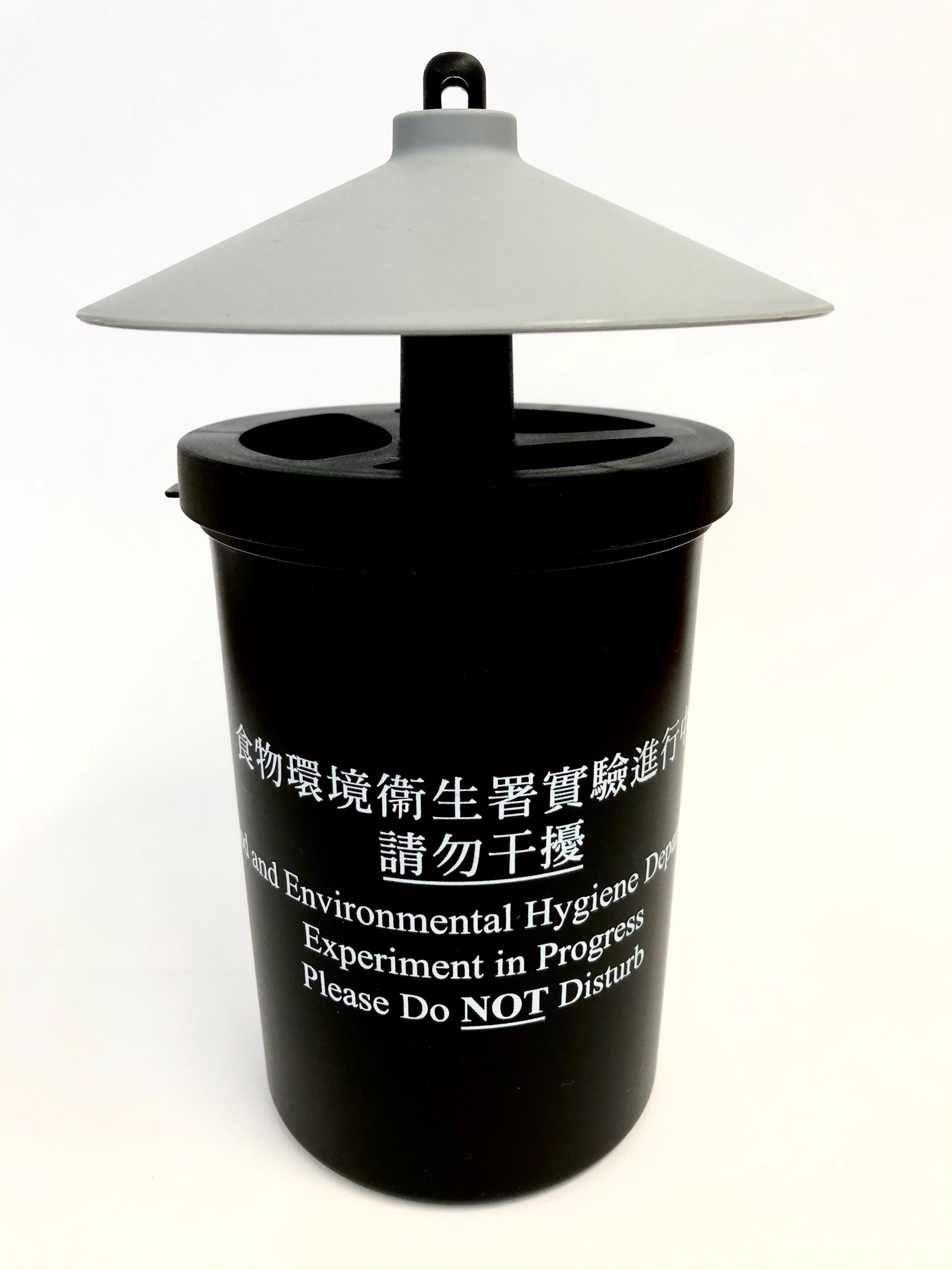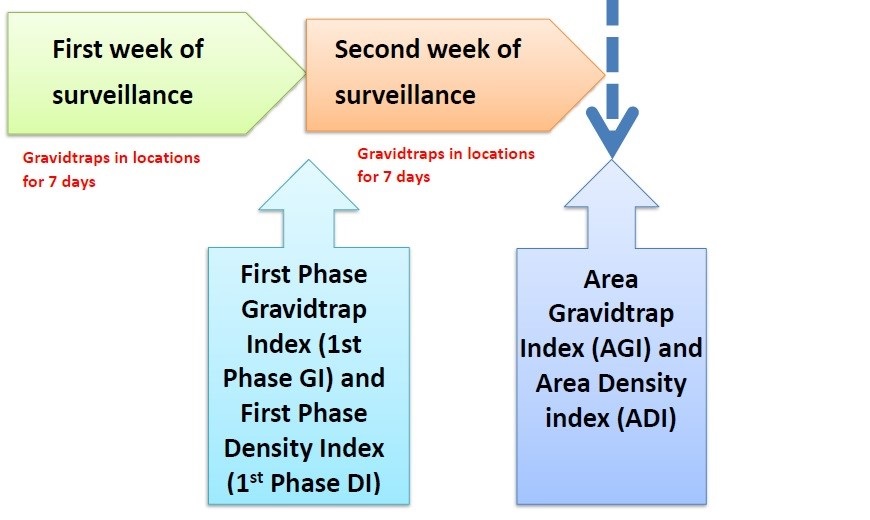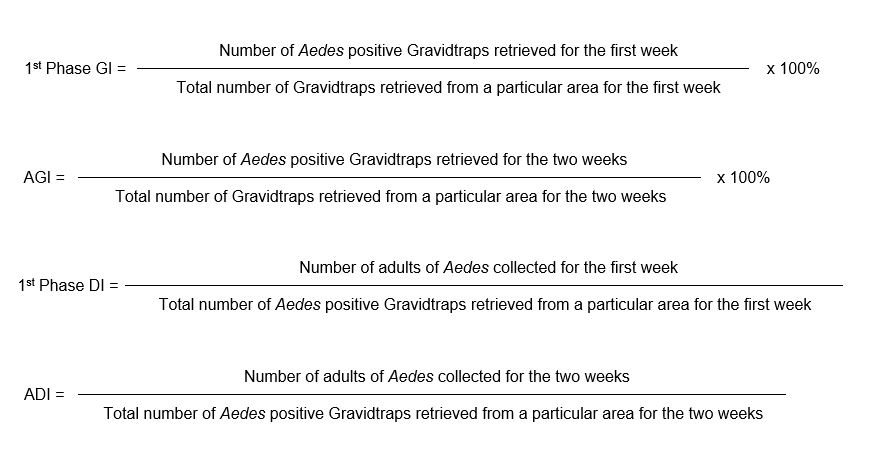Local Vector Biology
Aedes albopictus
- Eggs can withstand drought very well
- Breed in small containers such as cans, discarded tyres, tree holes, rock pools and bamboo ends holding small amount of water
- Adults rest in shrubby area
- Adult has a white stripe on the dorsal surface of thorax and bands on legs
- Although exophilic, adults may also enter into houses
- Day biter (Peak : within 2 hours after dawn and before sunset)
- Weak flier (about 100m)
- Vector of dengue fever
Vector Surveillance
Gravidtrap
Since 2000, the Food and Environmental Hygiene Department (FEHD) has been using Oviposition Trap (Ovitrap) to detect the presence of adult Aedine mosquitoes. Tools and methodology of dengue vector surveillance is reviewed from time to time and starting from April 2020, a new tool, Gravidtrap has been adopted to replace ovitrap for monitoring the dengue vector of Aedine mosquitoes. The Gravidtrap is a simple device made of a black plastic container of approximately 600ml with a glue board placed inside. It is covered by a black lid with openings and a raised grey cover.

Gravidtrap Index
To study the distribution of Aedes albopictus, Gravidtraps are set in selected areas throughout the territory for monitoring the breeding of these mosquitoes. The percentage of the Gravidtraps found positive with breeding of these mosquitoes gives the Gravidtrap Index for Aedes albopictus. The value of Gravidtrap Index for Aedes albopictus indicates the extensiveness of the breeding of the vectors.

Scope of Survey
At present, there are a total of 64 survey areas selected for the vector surveillance throughout the territory and the following four different indices will be enumerated:
- Area Gravidtrap Index for Aedes albopictus (AGI),
- Area Density Index for Aedes albopictus (ADI),
- Monthly Gravidtrap Index for Aedes albopictus (MGI), and
- Monthly Density Index for Aedes albopictus (MDI).
The AGI and ADI indicate the extensiveness of the distribution and density of Aedine mosquitoes respectively in that particular survey area, while the MGI and MDI are enumerated by pooling together all AGIs and ADIs of the same month reflecting the territory-wide situation of Aedes albopictus.
In addition to the areas in the community, surveys of Aedes albopictus are also carried out to cover all major port areas. The following two different groups of indices will be enumerated:
- Port / Port Monthly Gravidtrap Index for Aedes albopictus (PGI/PMGI), and
- Port / Port Monthly Density Index for Aedes albopictus (PDI/PMDI).
The Port Gravidtrap Index for Aedes albopictus (PGI) indicates the extensiveness of the distribution of Aedine mosquitoes in a particular group of port areas. The Port Monthly Gravidtrap Index for Aedes albopictus (PMGI) is enumerated by pooling together all PGIs of the same month, which reflects the overall degree of occurrence of Aedes albopictus in port areas. Another index, the Port Density Index for Aedes albopictus (PDI) indicates the density of Aedes albopictus in positive traps in a particular group of port areas. The Port Monthly Density Index for Aedes albopictus (PMDI) is enumerated by pooling together all PDIs of the same month, which denotes the overall density of Aedes albopictus in locales detected with Aedine mosquito activities in port areas.
Gravidtrap only detects activities of Aedine mosquitoes in the area where it is set. It cannot be used for detecting activities of other species of mosquitoes (such as Culex and Anopheline mosquitoes). The Gravidtrap Index for Aedes albopictus of an area reflects the extensiveness of the distribution of Aedine mosquitoes and the Density Index for Aedes albopictus of an area reflects the density of Aedes albopictus in the relevant surveillance area during the two weeks of surveillance. Apart from making reference to the relevant Gravidtrap Index and Density Index for Aedes albopictus, parties concerned should take into account other factors (such as the findings and reports on mosquito problem received) in planning and implementing their mosquito prevention and control work.
Survey Mechanism
The period for setting Gravidtraps in the survey areas is two weeks. During the survey period, the Gravidtraps are collected on a weekly basis. At the end of the first week of surveillance, all the Gravidtraps are retrieved and another batch of Gravidtraps is set at the same location for surveillance for the second week. The glue boards inside the retrieved Gravidtraps are immediately examined for the presence of adult Aedine mosquitoes (“Aedes-positive”) for the purpose of compiling the Gravidtrap Index (First Phase) and Density Index (First Phase). At the end of the second week of surveillance, all the Gravidtraps are retrieved and instantly checked for the presence of adult Aedine mosquitoes (“Aedes-positive”) on the glue boards. Data of the two weeks’ surveillance will be combined to obtain the Area Gravidtrap Index (AGI) and Area Density Index (ADI).
FEHD will notify its District Environmental Hygiene Offices and other relevant government departments of the Gravidtrap Indices and Density Indices of various phases once the figures are available, so that they can promptly carry out targeted mosquito prevention and control work. To facilitate public access to the latest survey data, FEHD will announce the phased indices for Aedes albopictus for each of the surveyed areas on the FEHD webpage. Corresponding mosquito prevention and control measures can be taken by the public in a more expeditious manner so as to prevent the spread of dengue fever.
The Gravidtrap Index and Density Index for Aedes albopictus of each surveyed area are released in two phases. Figures released in the first phases are phased indices and the second phase indices represent the AGI and ADI of the surveyed area in that month.


Level of Index
Gravidtrap Index
The Gravidtrap Index for Aedes albopictus is divided into four levels, reflecting the distribution level of the Aedes albopictus. Level 1 (less than 5 per cent) indicates that distribution of Aedes albopictus is not extensive in the area surveyed. Level 2 (5 per cent to less than 20 per cent) indicates that distribution of Aedes albopictus is fairly extensive in the area surveyed. Level 3 (20 per cent to less than 40 per cent) indicates that distribution of Aedes albopictus is extensive in the area surveyed. Level 4 (40 per cent or above) indicates that distribution of Aedes albopictus is very extensive in the area surveyed. Specific preventive and control measures will be initiated accordingly. Management of housing estates, hospitals, schools, construction sites and other venues or properties are also advised to take specific measures to contain mosquito problems in their own properties. The four levels of Gravidtrap Index for Aedes albopictus and actions to be taken by the management are listed in the following table.
| Level | Gravidtrap Index for Aedes albopictus | Actions to be taken |
|---|---|---|
| 1 | G.I. < 5% (Distribution of Aedes albopictus in the survey area is not extensive) |
|
| 2 | 5% ≤ G.I. < 20% (Distribution of Aedes albopictus in the survey area is fairly extensive) |
|
| 3 | 20% ≤ G.I. < 40% (Distribution of Aedes albopictus in the survey area is extensive) |
|
| 4 | G.I. ≥ 40% (Distribution of Aedes albopictus in the survey area is very extensive) |
The FEHD has set up a notification system in April 2011 to inform residential estates/buildings and construction sites that have joined the system in the area immediately when the Index has reached 20% or above. FEHD would provide residential estates / buildings and construction sites with specially designed notices for stakeholders to put up at appropriate places for the attention of residents and concerned parties and alert them to take preventive measures against the dengue vector. The notice should be posted until receipt of further notification.
Density Index
With the adoption of Gravidtraps since April 2020, a new index called the Density Index (DI) is also recorded in each survey area. It is denoted as Area Density Index (ADI) which is enumerated by dividing the number of adult Aedes by the total number of Aedes positive Gravidtraps during the survey period. The minimum value of the index is one.
The Density Index for Aedes albopictus is divided into three levels, reflecting the abundancy of Aedes albopictus. Level 1 (1 to 1.5) indicates that mosquito is not abundant in the locations with positive Gravidtraps. Level 2 (1.6 to 2.4) indicates that mosquito is slightly abundant in the locations with positive Gravidtraps. Level 3 (2.5 or above) indicates that mosquito is abundant in the locations with positive Gravidtraps. Specific preventive and control measures will be initiated accordingly. Management of housing estates, hospitals, schools, construction sites and other venues or properties will also be advised to take specific measures to contain mosquito problems in their own properties. The three levels of DI and actions to be taken by the management are listed in the following table.
| Level | Density Index for Aedes albopictus | Actions to be taken |
|---|---|---|
| 1 |
1 ≤ D.I. ≤ 1.5 |
|
| 2 |
1.6 ≤ D.I. ≤ 2.4 |
|
| 3 |
D.I. ≥ 2.5 |
|
Public should refer to the “Action to be taken” for AGI as primary reference. If both indices are of similar levels, their actions are also similar. However, if the AGI is low, e.g. Level 1 or Level 2, but level of ADI is high, e.g. Level 3, public should carry out actions for corresponding level of AGIs and supplement with actions for higher level of ADI, e.g. fogging, in locations with high mosquito density.
Please click here for Latest Index Information
Please click here for Record of Indices in 2024
Preventive Measures
Advice on mosquito control and prevention
Aedes albopictus (白紋伊蚊) is highly prevalent in Hong Kong. It breeds both in urban and rural areas and their breeding sites can be artificial receptacles like cans, lunch boxes, discarded tyres, clogged surface channels, containers; and naturally occurring tree holes, bamboo stumps and leaf axils.
Killing of mosquito larvae
Prevention is better than cure. As the mosquitoes have to breed in water, it is more effective and efficient to control mosquito at source at its aquatic stage. Pesticide should only be used for killing of mosquito in its breeding place or preventing its breeding if the breeding sources or potential breeding grounds are inaccessible or could not be eliminated for the time being. The followings must be noted for killing mosquito larvae:
- Larvicidal oil or larvicide (such as temephos, Bacillus thuringiensis subspecies israelensis etc.) can be applied to stagnant water directly with dosage according to the label instructions.
- Higher than required concentration of larvicide or excessive amount of larvicidal oil would not give better result on killing the mosquito larvae.
- The pesticides used must have been registered with the Agriculture, Fisheries and Conservation Department.
- Depending on the product, larvicide may be applied weekly into the stagnant water until the water has been removed.
- Larvicidal oil need not be applied into the stagnant water again if the oil is still present in the water.
- Pesticide applicator should put on protective gears including face mask and rubber gloves during pesticide application.
Killing of adult mosquito
Elimination of adult mosquitoes is relatively difficult as compared with that of the larvae. Adult mosquitoes usually disperse from their breeding place and hide in inconspicuous sites. The followings must be noted for killing adult mosquitoes:
- Adult mosquito can be killed by using household pesticides against flying insect with dosage according to the label instructions.
- The pesticides may be applied in form of aerosol, liquid spray, smoke (traditional mosquito coil) or vapour (electric mosquito mat/liquid).
- Do not spray the pesticides directly against functioning electrical appliances or flame to avoid explosion.
- Aerosol and liquid spray has to be applied directly to the adult mosquito for effective killing.
- Spraying of pesticide excessively on adult mosquito is not necessary for killing the insect.
- Mosquito coil and electric mosquito mat/liquid has to be placed near possible entrance, such as window, for mosquito.
- Care must be taken to ensure good ventilation and to avoid fire hazard on using mosquito coil.
Protection against adult mosquitoes
Adult mosquito attacks people for getting blood for laying eggs. The followings have to be noted for getting protection against adult mosquitoes:
- Windows and doors could be screened.
- Wear long-sleeved clothes and long trousers when going outdoors.
- Mosquito bednet could be used when the room is not air-conditioned.
- Bodies could be protected from mosquito bite by applying mosquito repellent on the clothes or skin according to label instructions.
- Some people may be allergic to insect repellent. Apply small amount of insect repellent to small area of the body to check for any allergic response before using the repellent.
Note: Always read and follow label instructions when using pesticides. Please also refer to the leaflet on Safe Use of Household Pesticides produced by Agriculture, Fisheries and Conservation Department for further information. (Web-site: https://www.afcd.gov.hk/english/quarantine/qua_pesticide/qua_pes_safe/qua_pes_safe.html ). The public can also call the telephone hotline of Food and Environmental Hygiene Department at Tel. No. 2868 0000 for more information on mosquito prevention and control.
Remark on mosquito control
Integrated pest management approach has to be adopted for the prevention and control of mosquito. Elimination of stagnant or/and slow running water is the fundamental and most effective mosquito prevention and control method. Application of chemical including pesticide should be the last resort and temporary measure for killing mosquito larvae. Space spraying against adult mosquitoes by using pesticide should only be carried out when there is an urgent need to reduce the number of adult mosquito such as preventing transmission of mosquito-borne diseases. Ecological impacts have to be taken into consideration for selecting the method(s) for mosquito control.
Advice to Public:
- To tidy up their premises and check for any accumulation of water inside their premises;
- To remove all unnecessary water collection and eliminate the sources;
- To change at least every week the water in flower vases and saucers of potted plants to prevent breeding of mosquitoes. The use of saucers should be avoided whenever possible;
- To properly cover all containers that hold water to prevent mosquito from accessing the water;
- To properly dispose articles that are able to contain water such as empty lunch boxes, cans and tyres;
- To stop storing water along morning walk trails or Government land for irrigation;
- To make large holes on tyres used as anti-bumping measure in garage to prevent water trapping or use mark(s) on the parking space to prevent bumping instead.
- To contact the district pest control offices or PCAS of FEHD, or pest control companies for assistance in mosquito control or prevention.
Anti-mosquito Measures
- Anti-mosquito Measures - Advice for Construction Sites
- Prevention of Dengue Fever (Advice for Housing Estates)
- Prevention of Dengue Fever (Advice for Schools)
- Prevention of Dengue Fever (Advice for Social Service Hostels / Homes)
- Prevention of Dengue Fever (Advice to Picnickers and Hikers)
- Anti-mosquito Measures - Advice for Hospitals / Clinics
- Anti-mosquito Measures - Advice for Ports
- Anti-mosquito Measures - Advice for Ferry
- Anti-mosquito Measures - Advice for Household (Chinese / English / Thai / Sinhalese / Indonesian / Japanese / Pakistani / Philippino / Nepali)

